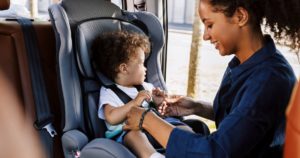New and Improved Child Seat Safety Standards
July 22, 2022 The National Highway Traffic Safety Administration (NHTSA) recently issued a final ruling on important updates to testing standards for child safety seats. These updates seek to provide children with more comprehensive protection during an accident, particularly in the case of a side-impact collision. According to the NHTSA, the new ruling is a significant advance in protecting children from sustaining serious bodily injury in traffic crashes.
The National Highway Traffic Safety Administration (NHTSA) recently issued a final ruling on important updates to testing standards for child safety seats. These updates seek to provide children with more comprehensive protection during an accident, particularly in the case of a side-impact collision. According to the NHTSA, the new ruling is a significant advance in protecting children from sustaining serious bodily injury in traffic crashes.
The National Library of Medicine (NLM) reports that children experience an increased risk for serious injury and death in side-impact, or T-bone, crashes. In fact, as compared to accidents involving other impact directions, like frontal and rear impact, side-impact collisions pose the most substantial threat to children’s safety. The NHTSA’s ruling is a much-needed response to these dangers. It amends the Federal Motor Vehicle Safety Standard No. 213 (Child restraint systems) by adding side-impact performance to the requirements for testing child safety seats. The NHTSA’s current standard only requires that child seats meet performance criteria for 30-mph front-impact crashes; the new standard requires that children’s safety seats also meet performance criteria for 30-mph side-impact collisions.
Side-Impact Crash Facts
Side-impact crashes can inflict serious bodily injury because the sides of a vehicle afford occupants with substantially less protection than the front and back. The NHTSA’s new standard will require using a test with side-impact test dummies modeled after a 3-year-old and 12-month-old child. The test simulates what happens to the children and their safety seats when a T-bone crash happens. Side-impact crashes result in some of the following injuries in children:
- Concussions and other types of traumatic brain injuries (TBIs)
- Broken limbs
- Internal decapitation
- Paralysis injuries
- Spinal cord injuries
According to the Centers for Disease Control and Prevention (CDC), certain risk factors accompany a child’s chance for sustaining severe injuries in an accident. The good news is, there are many ways to actively reduce these risks, like the NHTSA’s latest ruling on car seat testing standards. Here are some examples from the CDC of risk factors for motor vehicle collisions and ways to address them:
- In 2019, 608 child passengers aged 12 and younger died in automobile accidents and 91,000 others sustained injuries. 38% of children who died were not wearing a seat belt or properly restrained in a child car safety seat at the time of the incident
- Properly restraining young children often depends on the driver’s own seat belt use. Of the total deadly incidents that occurred in 2019, 67% of the fatally injured children were riding with a driver who was not wearing a seat belt
- Even when children are restrained in a car safety or booster seat, parents and caregivers often use the restraint systems incorrectly. An estimated 46% of car and booster seats are misused in a way that could reduce their overall effectiveness
- When used properly, car seats reduce the risk of injury in a crash anywhere from 71% to 82% in children as compared to seat belt use alone
- Properly installed and used booster seats reduce serious injury risks by 45% in children between the ages of 4 and 7-years-old compared to seat belt use alone
- For older children, seat belt use decreases the risk of death and serious injury by approximately 50%
Improving car seat testing requirements and continuing to strengthen other current laws are both key in safeguarding children. The CDC also advocates for car seat distribution plus education programs, which help parents and caregivers obtain new, unused car seats and learn how to properly use and install them. Often these programs include hands-on demonstrations, which also helps to increase the rate of proper use and installation.
What to Do if Your Child Was Injured in a Car Accident
There are numerous reasons why a car accident might occur. If your child was injured in a crash caused by someone else, an experienced car accident attorney can help you to recover damages to ensure that your family is not negatively impacted by financial hardship after the event. At Galfand Berger, our team of lawyers has decades of experience with car accident victims and their families recoup losses associated with medical bills, continuing medical care, lost wages, pain and suffering, and punitive damages. Some top-contributing factors behind automobile accidents include distracted driving, drowsy driving, aggressive driving, drunk or impaired driving, reckless or careless driving, failure to signal and speeding. Our attorneys can help your family determine who was responsible for causing the accident and make sure that your child and loved ones receive the assistance that they deserve. If you would like to learn more, contact a representative who can help online now.
Philadelphia Personal Injury Lawyers at Galfand Berger, LLP, Representing Automobile Accident Victims Since 1947
If you have a question about filing a legal claim, contact the Philadelphia automobile accident lawyers at Galfand Berger LLP today. Call us at 800-222-USWA (8792) or fill out our online form for a free consultation. Located in Philadelphia, Bethlehem, Lancaster, and Reading, we serve clients throughout New Jersey and Pennsylvania, including Allentown and Harrisburg.
 Google Screened
Google Screened
